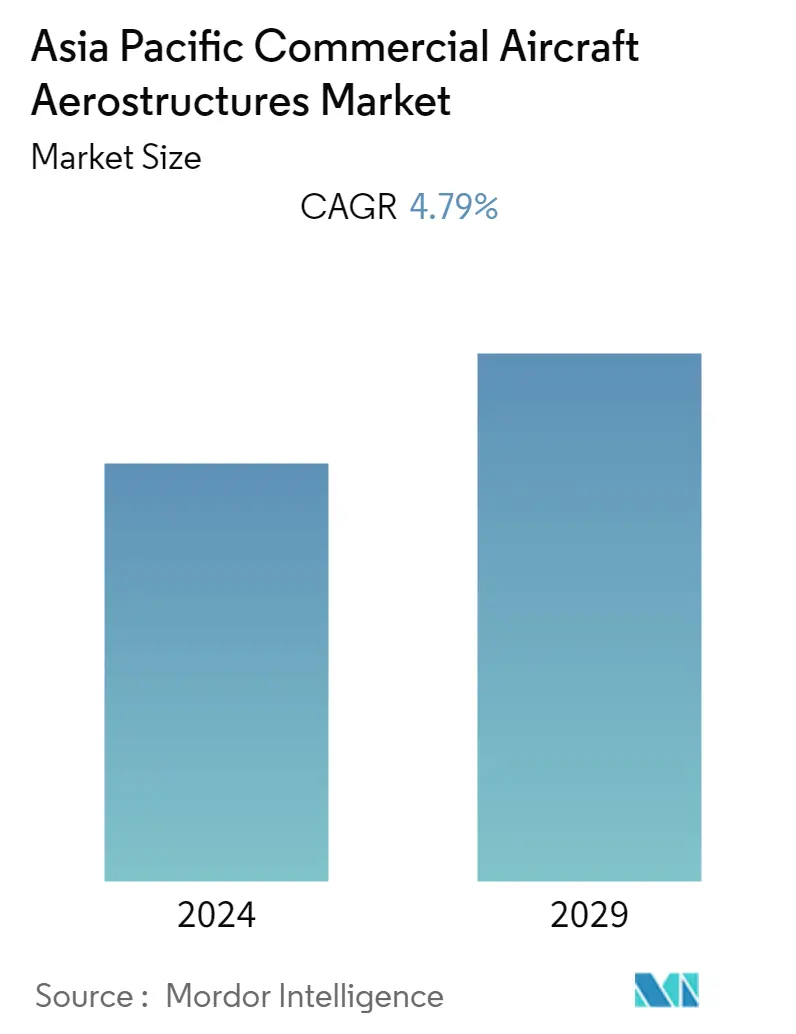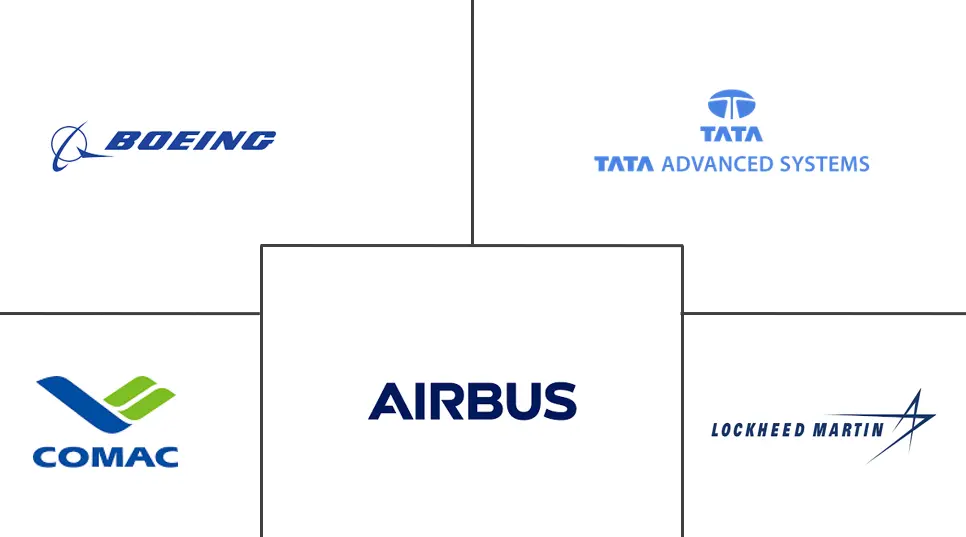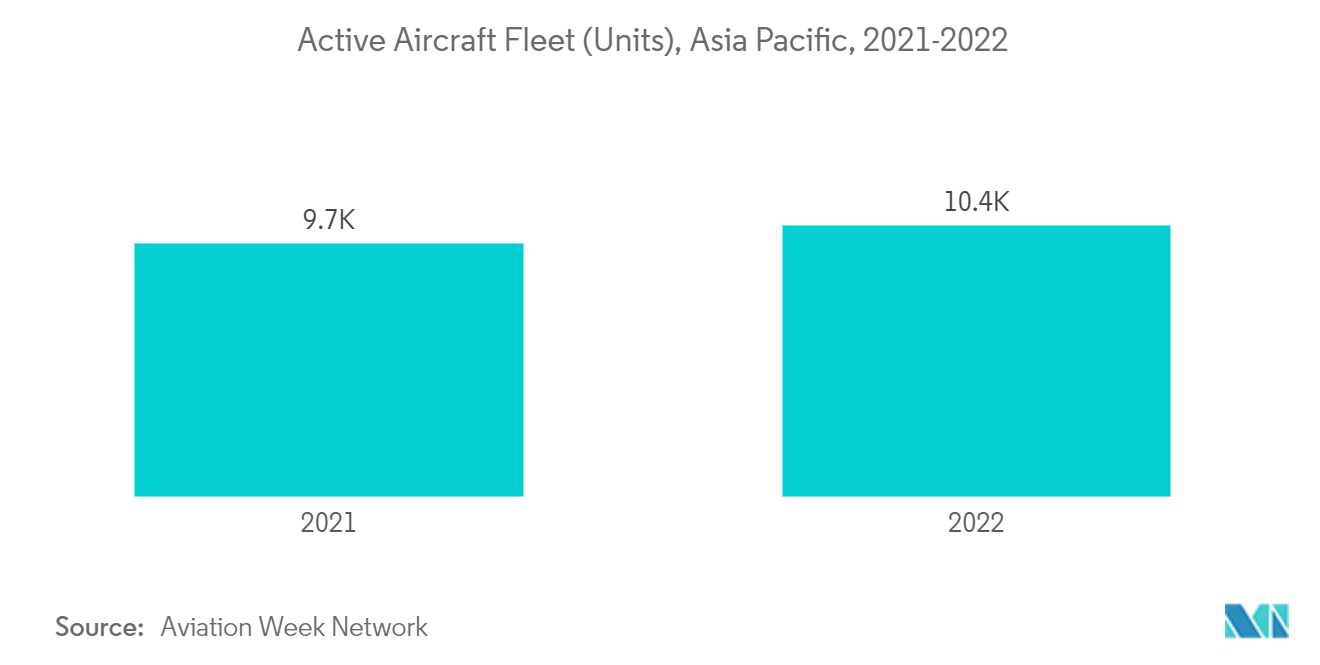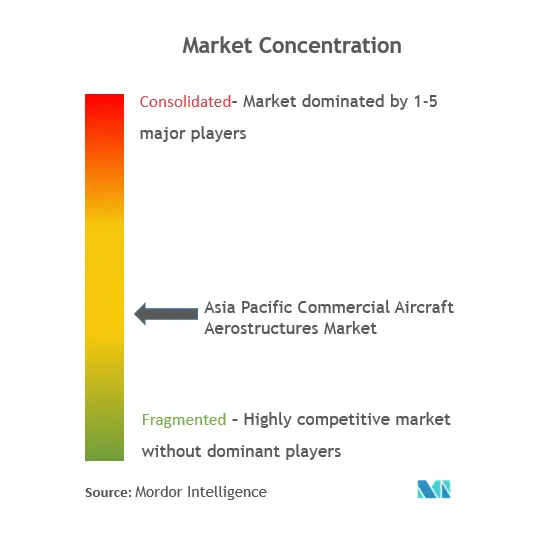Asia Pacific Commercial Aircraft Aerostructures Market Size

| Study Period | 2020 - 2029 |
| Base Year For Estimation | 2023 |
| Forecast Data Period | 2024 - 2029 |
| Historical Data Period | 2020 - 2022 |
| CAGR | 4.79 % |
| Market Concentration | Medium |
Major Players
*Disclaimer: Major Players sorted in no particular order |
Asia Pacific Commercial Aircraft Aerostructures Market Analysis
- The Asia Pacific commercial aircraft aerostructures market is anticipated to grow at a CAGR of 4.79% during the forecast period.
- The COVID-19 pandemic severely impacted the aviation sector across the Asia Pacific. According to the International Air Transport Association (IATA), Asia-Pacific airlines recorded a revenue decline of USD 113 billion in 2020 compared to the previous year due to the pandemic, which was the largest drop among all regions. However, the market has shown strong signs of recovery post-COVID due to increased air passengers, rising procurement of commercial aircraft, and growing aircraft modernization programs.
- The increase in air passenger traffic has led to a higher demand for new aircraft, which is expected to drive market growth. According to CH Aviation, the global air fleet size increased in 2022, and the active air fleet in September 2022 witnessed a 5% year-on-year growth. The active air fleet in the Asia-Pacific region in September 2022 was 10,894, consisting of 8,695 active and 2,199 aircraft.
- As the aviation industry evolves technologically, aircraft manufacturing companies are researching and developing new, advanced, and composite materials that provide more strength and durability while weighing less. Despite the few restraints mentioned above, the market is expected to grow during the forecast period, given the increasing demand for commercial aircraft.
Asia Pacific Commercial Aircraft Aerostructures Market Trends
Composites Segment is Estimated to Show Significant Growth During the Forecast Period
- Asia Pacific has shown the highest growth in the number of air travelers in recent years, driven by increased spending on the aviation sector and a rising number of passengers, particularly in India and China. According to the International Air Transport Association (IATA), Asia-Pacific airlines experienced a 464.8 percent increase in September 2022 compared to the same period last year, the strongest year-over-year growth rate among all regions.
- Passenger capacity also rose by 165 percent in 2022. In addition, there were 633 known projects at existing airports globally in 2022, with a total investment of USD 565.7 billion. Of these projects, Asia Pacific is among the largest spenders on airport infrastructure, with 228 ongoing infrastructure projects valued at USD 227 billion. Thus, the growing investment in the aviation sector drives the demand for new commercial aircraft and their components, including composite materials.
- Composite materials are widely used in aerospace applications, including brackets, engine blades, nacelles, interiors, single aisle wings, propellers/rotors, and wide-body wings, due to their lightweight, high strength, and good fatigue resistance. These materials have exceptional strength and stiffness-to-density ratios and superior physical properties. A composite material typically consists of relatively strong, stiff fibers in a tough resin matrix, with carbon fiber, glass, and aramid-reinforced epoxy being the three main types used in aerospace. Composite materials have played a vital role in reducing the weight of aerostructures, accounting for more than 20% of the A380's airframe. Glass-fiber-reinforced and carbon-fiber-reinforced polymers (CFRPs) are used extensively in fuselage sections, wings, doors, and tail surfaces.
- For instance, in July 2021, Markforged, the creator of the integrated metal and carbon fiber additive manufacturing platform, the Digital Forge, launched two composite materials, Onyx™ FR-A, and Carbon Fiber FR-A, for aerospace and other applications. This demonstrates the growing use of advanced composite materials that provide high stiffness, strength, and reduced weight of aerostructures, thereby driving the growth of the market.

India Will Showcase Remarkable Growth During the Forecast Period
- In the current scenario, India is experiencing a significant surge in aircraft manufacturing, air passenger traffic, and commercial aircraft deliveries. The growth in air passenger traffic, along with government investments and support, as well as the need for aircraft with advanced aerostructures, is expected to propel the market to grow significantly in the coming years.
- As per the data released by the Ministry of Civil Aviation in February 2023, the Indian aviation sector witnessed a total of 6,060 domestic aircraft movements, with 3,026 departing and 3,034 arriving flights, carrying a total of 845,941 domestic passengers. Additionally, there were 947 international aircraft movements, with 515 international flights landing in India and 432 flights departing from India, carrying a total of 162,991 passengers. Furthermore, India's air passenger traffic grew by 47% year-on-year to reach 123.2 million passengers in 2022, indicating a strong recovery from the travel slump witnessed in 2021 and 2020 due to the COVID pandemic.
- Furthermore, there has been significant growth in aircraft deliveries in India over the past few years. Several Indian airline companies are now upgrading or replacing their fleet of old aircraft with new and advanced models.
- For instance, in February 2023, Air India announced its plans to purchase a record number of passenger airplanes to compete for a greater share of the booming domestic and international air travel market. The order includes 190 B737 MAX jets, 20 Boeing B787 Dreamliners, and ten widebody B777X planes, for a total of 220 aircraft. Additionally, Air India is ordering 250 airplanes from European manufacturer Airbus, including 210 A320 Neo narrow-body planes and 40 A350 wide-body aircraft.
- Similar initiatives to foster the aviation manufacturing industry in India are expected to have a positive impact on the commercial aircraft aerostructures market in the country during the forecast period.

Asia Pacific Commercial Aircraft Aerostructures Industry Overview
The market is moderately fragmented and features several local players in addition to global technology providers. Some of the key players in the market are The Boeing Company, Lockheed Martin Corporation, Commercial Aircraft Corporation of China (COMAC), Airbus SE, and TATA Advanced Systems Ltd. These key players are focusing on introducing advanced technologies to reduce weight, improve reliability, and enhance the performance of aerostructures. Moreover, they aim to expand their businesses through contracts, partnerships, and new product launches.
For example, in August 2022, Kaiser Aluminum signed a long-term contract with Boeing to supply sheet and light gauge aluminum plates for use in Boeing's commercial aircraft products.
Asia Pacific Commercial Aircraft Aerostructures Market Leaders
-
The Boeing Company
-
Airbus SE
-
Lockheed Martin Corporation
-
Commercial Aircraft Corporation of China (COMAC)
-
TATA Advanced Systems Ltd.
*Disclaimer: Major Players sorted in no particular order

Asia Pacific Commercial Aircraft Aerostructures Market News
- September 2022: Infosys signed a five-year agreement with Spirit AeroSystems to provide aerostructure and systems engineering services for the development of commercial aircraft and business jets, as well as maintenance, repair, and overhaul (MRO) services.
- January 2021: ST Engineering announced that it had entered into a 10-year agreement with Honeywell Aerospace. Under the agreement, ST Engineering will provide component MRO and warranty repair services to all Asia-Pacific operators for Honeywell's components.
APAC Commercial Aircraft Aerostructures Market Report - Table of Contents
1. INTRODUCTION
1.1 Study Assumptions
1.2 Scope of the Study
2. RESEARCH METHODOLOGY
3. EXECUTIVE SUMMARY
4. MARKET DYNAMICS
4.1 Market Overview
4.2 Market Drivers
4.3 Market Restraints
4.4 Porter's Five Forces Analysis
4.4.1 Threat of New Entrants
4.4.2 Bargaining Power of Buyers/Consumers
4.4.3 Bargaining Power of Suppliers
4.4.4 Threat of Substitute Products
4.4.5 Intensity of Competitive Rivalry
5. MARKET SEGMENTATION
5.1 Material
5.1.1 Alloys
5.1.2 Composites
5.1.3 Metals
5.2 End User
5.2.1 OEM
5.2.2 Aftermarket
5.3 Country
5.3.1 China
5.3.2 India
5.3.3 Japan
5.3.4 South Korea
5.3.5 Indonesia
5.3.6 Australia
5.3.7 Rest of Asia-Pacific
6. COMPETITIVE LANDSCAPE
6.1 Vendor Market Share
6.2 Company Profiles
6.2.1 Aviation Industry Corporation of China Ltd.
6.2.2 Cyient Ltd.
6.2.3 Airbus SE
6.2.4 Commercial Aircraft Corporation of China (COMAC)
6.2.5 Mitsubishi Aircraft Corporation
6.2.6 The Boeing Company
6.2.7 Lockheed Martin Corporation
6.2.8 Embraer SA
6.2.9 Mahindra Aerospace Pvt. Ltd.
6.2.10 Tata Advanced Systems Ltd (TASL)
7. MARKET OPPORTUNITIES AND FUTURE TRENDS
Asia Pacific Commercial Aircraft Aerostructures Industry Segmentation
An aircraft aerostructure is a separately manufactured unit or component of an aircraft's airframe that includes fuselage, wings, nacelles, and flight control surfaces. Aerostructures together support the aircraft by acting as a skeleton on which other equipment and devices are mounted or integrated.
The Asia Pacific commercial aircraft aerostructures market is segmented by material, end-user, and country. By material, the market is segmented into alloys, composites, and metals. By end-user, the market is segmented into original equipment manufacturer (OEM) and aftermarket. By geography, the market is segmented into China, India, Japan, South Korea, Indonesia, Australia, and the rest of Asia Pacific.
The market sizing and forecasts have been provided in value (USD billion) for all the above segments.
| Material | |
| Alloys | |
| Composites | |
| Metals |
| End User | |
| OEM | |
| Aftermarket |
| Country | |
| China | |
| India | |
| Japan | |
| South Korea | |
| Indonesia | |
| Australia | |
| Rest of Asia-Pacific |
APAC Commercial Aircraft Aerostructures Market Research FAQs
What is the current Asia Pacific Commercial Aircraft Aerostructures Market size?
The Asia Pacific Commercial Aircraft Aerostructures Market is projected to register a CAGR of 4.79% during the forecast period (2024-2029)
Who are the key players in Asia Pacific Commercial Aircraft Aerostructures Market?
The Boeing Company, Airbus SE, Lockheed Martin Corporation, Commercial Aircraft Corporation of China (COMAC) and TATA Advanced Systems Ltd. are the major companies operating in the Asia Pacific Commercial Aircraft Aerostructures Market.
What years does this Asia Pacific Commercial Aircraft Aerostructures Market cover?
The report covers the Asia Pacific Commercial Aircraft Aerostructures Market historical market size for years: 2020, 2021, 2022 and 2023. The report also forecasts the Asia Pacific Commercial Aircraft Aerostructures Market size for years: 2024, 2025, 2026, 2027, 2028 and 2029.
Asia Pacific Commercial Aircraft Aerostructures Industry Report
Statistics for the 2024 Asia Pacific Commercial Aircraft Aerostructures market share, size and revenue growth rate, created by Mordor Intelligence™ Industry Reports. Asia Pacific Commercial Aircraft Aerostructures analysis includes a market forecast outlook to for 2024 to 2029 and historical overview. Get a sample of this industry analysis as a free report PDF download.



